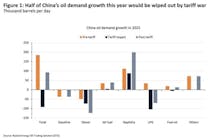EIA forecasts higher global oil prices, growing volatility
The US Energy Information Administration still sees higher global crude oil demand and prices over the long run as national economies recover, but expects markets to grow more volatile in the near- to midterm as demand uncertainties multiply, acting EIA Administrator Howard K. Gruenspecht said as he released EIA’s latest International Energy Outlook (IEO).
“We do see some substantial growth—about 53% from 2008 to 2035—in world energy consumption,” Gruenspecht said during a presentation at the Center for Strategic and International Studies. “Nearly all of it will take place outside the [Organization for Economic Cooperation and Development], driven by economic growth, with the non-OECD projected share rising to about two-thirds by 2035. About half is coming from China and India alone.”
But Gruenspecht added that EIA’s projections are tempered by overseas economic recoveries that are taking longer than expected. “Debt levels in many advanced developed nations could have near-term impacts on energy growth,” he said. “There are questions whether China, India, and similar countries can continue their high energy and economic growth because of growing debt.”
Renewable energy was the fastest growing energy source in the forecast’s reference case (2.8%/year from a 10% share in 2008 to 15% in 2035). But fossil fuels, with a 79% share, remained the single-largest source, even though it was less than its 85% share in 2008.
Liquids remained the largest share of energy consumed worldwide, primarily because of continued strong transportation use, but fell from 35% of total energy consumed in 2008 to 28% in 2035. “We see liquid fuels demand growing dramatically in the reference case to 112 million b/d in 2035 from around 81 million b/d in 2008,” Gruenspecht said. High oil prices could dampen some of that growth and encourage fuel switching where possible and a modestly increased use of liquid biofuels, he added.
Up to $125/bbl
“We do see oil prices in real terms continuing to rise as the world’s economies recover, demand grows, and supply growth faces real above-ground and below-ground challenges,” said Gruenspecht. Prices reach $125/bbl under the new IEO reference case as the Organization of Petroleum Exporting Countries tries to retain its market share, he continued.
High prices and more market volatility are likelier now than they were in the 1986-2000 period because spare production capacity is significantly lower and producing nations see no incentive to increase it immediately, he observed. But high prices also will probably increase conventional production outside OPEC, with Russia, the US, Brazil, and Kazakhstan offsetting declines in Europe and Mexico, Gruenspecht said.
Production also could grow from more use of enhanced oil recovery, refining gains, and more recovery of crude from shale formations, he said. “There’s not a lot of shale oil outside of North America, but the question is whether it will follow the trend of shale natural gas and begin to grow elsewhere,” Gruenspecht said.
“Reference case oil prices are at high levels, reflecting more unconventional sources from both OPEC and non-OPEC suppliers,” he indicated. “They become competitive particularly when political factors restrict access to more conventional supplies.”
The forecast’s OPEC production outlook also is less certain than previously. The new 2035 production projection for Saudi Arabia of 15 million b/d is down from the 2010 IEO, he noted. The new forecast also doesn’t consider possible political changes, such as higher production from Iraq, that could affect OPEC’s share of total world oil output.
“Clearly, sanctions and other financial and institutional constraints that are restricting development of abundant resources in other countries could be alleviated,” said Gruenspecht. “Recent political unrest in North Africa and elsewhere also remind us that there’s growing price and production uncertainty.”
Contact Nick Snow at [email protected].

Nick Snow
NICK SNOW covered oil and gas in Washington for more than 30 years. He worked in several capacities for The Oil Daily and was founding editor of Petroleum Finance Week before joining OGJ as its Washington correspondent in September 2005 and becoming its full-time Washington editor in October 2007. He retired from OGJ in January 2020.

